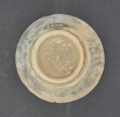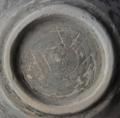MI·2
| Inscription | |
|---|---|
| Reading in transliteration: | atep |
| Reading in original script: | |
|
| |
| Object: | MI·2 Parabiago (cup) |
| Position: | foot, outside |
| Direction of writing: | dextroverse |
| Script: | prob. North Italic script (Lepontic alphabet) |
| adapted to: | Latin script |
| Letter height: | 0.6–1 cm0.236 in <br />0.394 in <br /> |
| Number of letters: | 4–5 |
| Number of words: | 1 |
| Number of lines: | 1 |
| Workmanship: | scratched after firing |
| Condition: | complete |
|
| |
| Archaeological culture: | Augustan [from object] |
| Date of inscription: | late 1st c. BC [from object] |
|
| |
| Type: | unknown |
| Language: | unknown |
| Meaning: | unknown |
|
| |
| Alternative sigla: | Solinas 1995: 109 Morandi 2004: 132 |
|
| |
| Sources: | Morandi 2004: 611 no. 132 |
Images
Commentary
First published in Tizzoni 1984: 72, no. 3. Examined for LexLep on 28th April 2022.
Images in Tizzoni 1984: tav. XLIV e (drawing = Solinas 1995: 367, no. 109), Frontini 1985: tav. 16.12 (drawing).
Inscribed in a curve on the foot of the cup, with the upper parts of the letters pointing outward. Initial alpha is retrograde and has a shortened first hasta; it may well have been intended as ![]() rather than
rather than ![]() . The bar of tau is slightly tilted in writing direction. Tizzoni's drawing correctly shows
. The bar of tau is slightly tilted in writing direction. Tizzoni's drawing correctly shows ![]() as the final letter; Morandi accordingly reads
as the final letter; Morandi accordingly reads ![]()
![]()
![]()
![]()
![]() atiil or atiip, assuming an abbreviated personal name and comparing specifically atilonei. Frontini's drawing shows non-retrograde alpha
atiil or atiip, assuming an abbreviated personal name and comparing specifically atilonei. Frontini's drawing shows non-retrograde alpha ![]() as the final letter, and also Tibiletti Bruno 1984: 123 reads alpha (discounting the bar of tau and reading upsilon
as the final letter, and also Tibiletti Bruno 1984: 123 reads alpha (discounting the bar of tau and reading upsilon ![]() as second letter, followed by a single iota → auia in Latin script). However, the impression of a lower bar in the last letter is due to one of the concentric circles on the foot (and a combination of two different forms of alpha would be unlikely anyway); the last letter is either pi or, less likely, inverted lambda. Double iota is unusual; since Latin or Latinised script is indicated by tau with a hasta and made plausible by the low dating, the two verticals could be cursive Latin epsilon
as second letter, followed by a single iota → auia in Latin script). However, the impression of a lower bar in the last letter is due to one of the concentric circles on the foot (and a combination of two different forms of alpha would be unlikely anyway); the last letter is either pi or, less likely, inverted lambda. Double iota is unusual; since Latin or Latinised script is indicated by tau with a hasta and made plausible by the low dating, the two verticals could be cursive Latin epsilon ![]() . atep is thus more likely epigraphically, and could be an abbreviation of a personal name like ateporix vel sim. (see the word page).
. atep is thus more likely epigraphically, and could be an abbreviation of a personal name like ateporix vel sim. (see the word page).
Bibliography
| Casini & Fossati 2013b | Stefania Casini, Angelo E. Fossati, "L'alfabeto latino inciso sul masso Camisana 1 di Carona (Bergamo)", Notizie Archeologiche Bergomensi 21 (2013), 147–155. |
|---|---|
| Frontini 1985 | Patrizia Frontini, La ceramica a vernice nera nei contesti tombali della Lombardia [= Archeologia dell'Italia Settentrionale 3], Como: 1985. |


